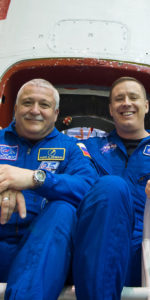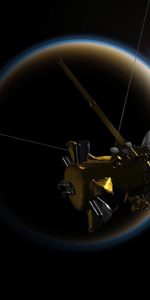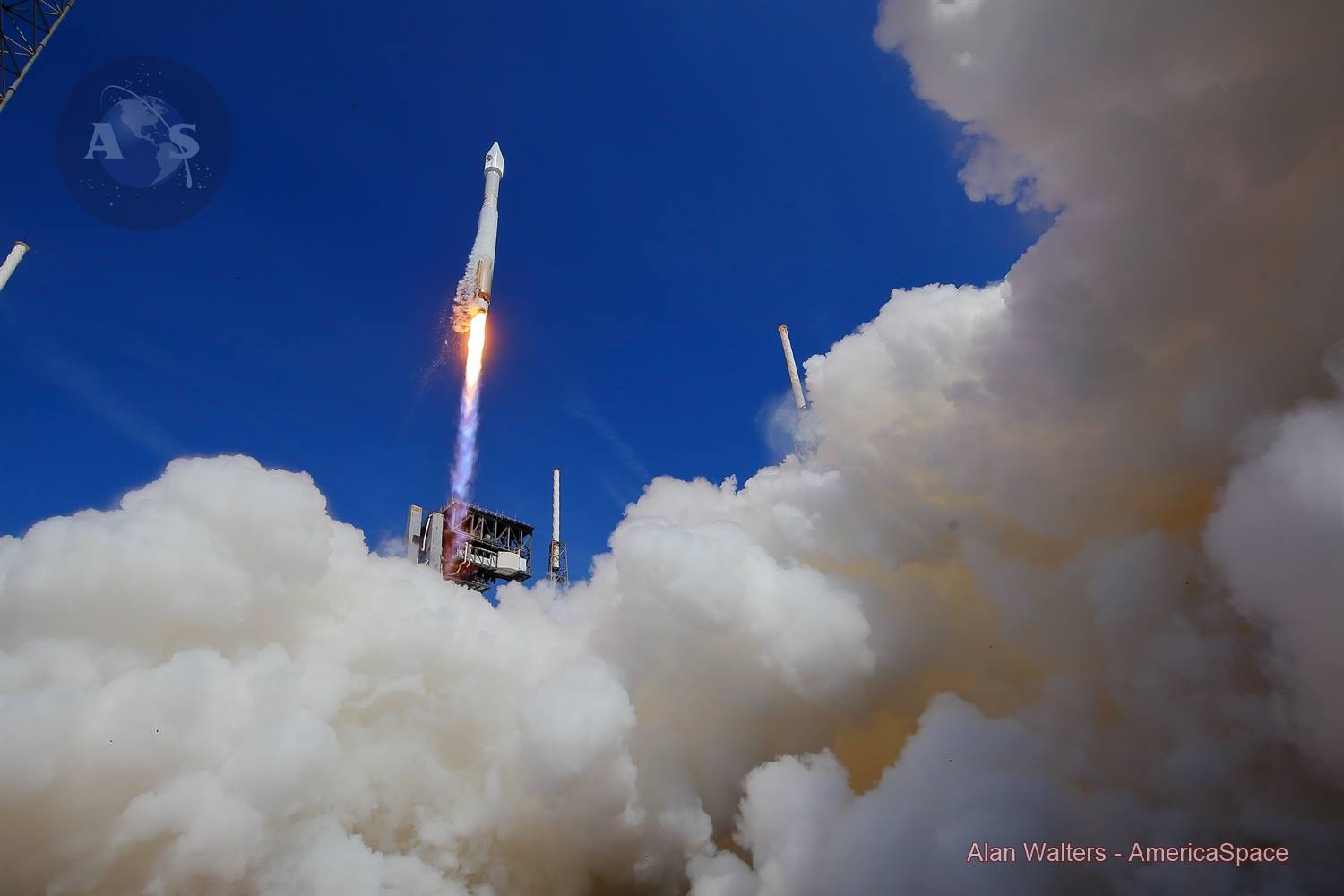
Despite being the “barebones” member of the fleet, the pencil-like Atlas V 401 today cemented its credentials as the most-flown vehicle in United Launch Alliance’s (ULA) Atlas V inventory. With the spectacular launch of Orbital ATK’s OA-7 Cygnus cargo mission to the International Space Station (ISS), the “401”—so named because it carries a 13-foot-diameter (4-meter) payload fairing, no strap-on rockets and a single-engine Centaur upper stage—has now completed more than 50 percent of all Atlas V launches. Flying its third ISS-bound mission on behalf of Orbital ATK and NASA in only 16 months, the vehicle enjoyed a smooth countdown, punctuated only by a couple of ground anomalies.
Liftoff occurred on-time at 11:11 a.m. EDT Tuesday, right on the opening of a 30-minute “window” and took place under beautiful April skies on the Florida coast. Rising from Space Launch Complex (SLC)-41 at Cape Canaveral Air Force Station, the Atlas V successfully injected Cygnus—nicknamed “Space Ship (S.S.) John Glenn”, honoring the former Project Mercury and shuttle astronaut, who died last year—into low-Earth orbit, where it will perform a rendezvous and berthing at the ISS on Saturday morning. It is fitting the the Atlas V is a modern incarnation of the Atlas-D booster which Glenn himself rode on 20 February 1962 to become the first American citizen to orbit the globe.
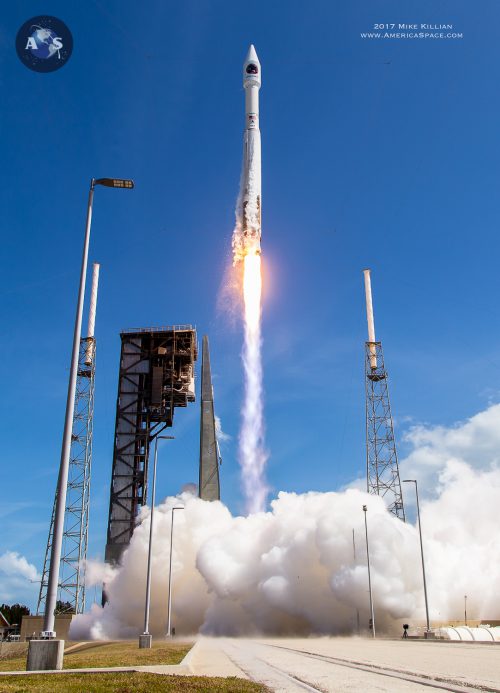
“John Glenn lived a life filled with firsts and broke barriers throughout his career,” said Brig. Gen. Wayne Monteith, 45th Space Wing Commander and Launch Decision Authority for today’s launch. “I am proud of the integrated Space Coast team who worked together flawlessly to make this launch a success. This mission once again clearly demonstrates the successful collaboration we have with our mission partners at NASA and ULA, as we continue to shape the future of America’s space operations and serve as the World’s Premier Gateway to Space.”
As outlined in AmericaSpace’s OA-7 preview article, this mission was originally scheduled for launch in the latter part of March, but was postponed due to hydraulic issues—including a ruptured fluid line—on the ground and associated with the Common Core Booster (CCB) first stage of the Atlas V. This prompted ULA to delay the launch by a few days, to allow engineers to attempt a timely resolution of the problem, before erring on the side of caution and announcing a longer delay until mid-April. Yesterday (Monday), the 194-foot-tall (59-meter) Atlas V was rolled the quarter-mile (400 meters) from the Vertical Integration Facility (VIF) to the SLC-41 pad surface. ULA engineers then set to work centering the stack and establishing propellant umbilicals and electrical and data connections.
Shortly after 2 p.m. EDT Monday, ULA CEO Tory Bruno tweeted that efforts had begun to load 20,800 gallons (94,600 liters) of “storable” RP-1—a highly refined form of rocket-grade kerosene—into the tanks aboard the CCB. Tuesday dawned bright, figuratively and literally, with a marked increase in the likelihood of acceptable weather conditions at T-0 from 80-percent to 90-percent favorable. According to the 45th Space Wing at Patrick Air Force Base, there was just a “slight chance” of coastal showers and winds peaking below 10 knots, with a 10-percent likelihood of a scrub based on a violation of the Cumulus Cloud Rule. “Winds are light, isolated showers possible,” tweeted Mr. Bruno. “Feels like a good day to go to space.”
Formal countdown operations got underway shortly before sunrise Tuesday, when the flight control systems aboard the Atlas V were brought online and ground command, control and communications assets were activated. Fuel lines were purged with gaseous nitrogen and at 8:40 a.m. the countdown resumed following the first of two 30-minute built-in holds, whereupon a formal “Go” was issued to begin loading cryogens aboard the CCB and the Centaur. All told, 44,000 gallons (200,000 liters) of liquid oxygen were pumped aboard the first and second stages, together with 10,580 gallons (48,100 liters) of liquid hydrogen into the Centaur.
With the conclusion of fueling, the countdown entered its second 30-minute built-in hold at 10:37 a.m. EDT, at which point the clock was stopped at T-4 minutes. During this period, with all propellant tanks confirmed at flight levels, the liquid oxygen transitioned to a “topping” mode, whereby the boiled-off cryogens were continuously replenished until close to T-0. “Cryogenic tanking complete,” tweeted Mr. Bruno at 10:39 a.m. “Board remains green.” In spite of the ideal April weather at the Cape, a couple of technical anomalies had cropped up, earlier in the countdown. A batch of suspect sensor readings and a possible leak from a first-stage chill-down line were carefully monitored and a voltage issue with the Flight Termination System (FTS) was also identified and later resolved.
At 10:50 a.m., the OA-7 Cygnus transitioned to internal power, running off its on-board batteries until such time that it achieved orbit and could deploy its electricity-generating solar arrays. The Launch Team produced a unanimous “Go” across the board, allowing the countdown to emerge from the hold at T-4 minutes at 11:07 a.m. In the final phase of the countdown, the propellant tanks were pressurized and the FTS—which is tasked with destroying the vehicle in the event of a major, off-nominal contingency—was placed onto internal power and armed.
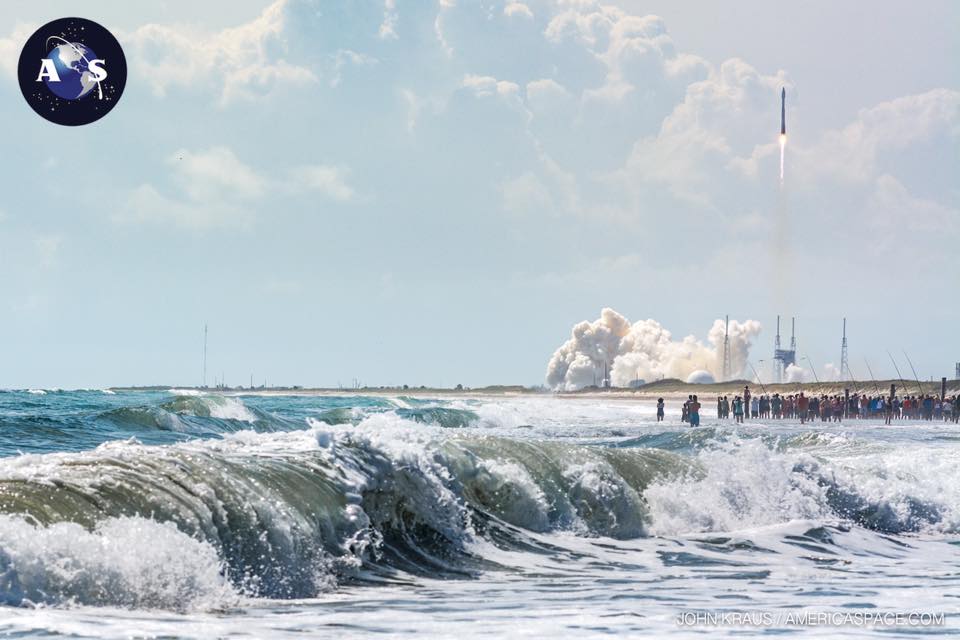
Under normal circumstances, when flying Orbital ATK’s Antares or SpaceX’s Upgraded Falcon 9 on ISS-bound missions, an “instantaneous” launch window, timed to the second, is essential, in order to establish proper orbital parameters and conditions for rendezvous. The capabilities of the Atlas V, on the other hand, afford greater flexibility. Integral to this flexibility is Right Ascension of the Ascending Node (RAAN) steering, which allows the Centaur avionics to steer the vehicle into the orbital plane of the space station, even if it launched “out-of-plane” or considerably later in the window. Short windows “can significantly limit the probability of an on-time launch”, said Jim Sponnick, ULA’s vice president for Atlas and Delta programs, in comments previously provided to AmericaSpace. Mr. Sponnick added that ULA “strives to implement longer launch windows in our mission designs to maximize the probability of a first-day launch for our customers”.
The Russian-heritage RD-180 engine ignited at T-2.7 seconds, ramping up to 860,000 pounds (390,000 kg) of propulsive yield, before leaving SLC-41 at T+1.1 seconds. “And liftoff of the Atlas V rocket with Cygnus and the S.S. John Glenn,” exulted NASA announcer George Diller, “extending the research legacy for living and working in space.” Climbing vertically for the first portion of ascent, the Centaur avionics commanded a pitch, roll and yaw program maneuver to establish the vehicle onto a precise flight azimuth of 44.4 degrees. At the time of liftoff, the space station and its incumbent Expedition 51 crew of Commander Peggy Whitson and Flight Engineers Oleg Novitsky and Thomas Pesquet were orbiting about 255 miles (410 km) above the English Channel.
The RD-180 burned hot and hard for about four minutes, shutting down at 11:16 a.m. and separating shortly thereafter. This set up the proper conditions for the restartable RL-10C engine of the Centaur to fulfil its part of the mission: to establish the heavyweight Cygnus in low-Earth orbit. The progress of the initial burn—which Mr. Bruno described as “straight down the pipe” in terms of its flight characteristics—saw the Extra-Extended Payload Fairing (XEPF) jettisoned, as expected, to expose Cygnus to the space environment for the first time. By this point in the ascent, the Atlas V had already expended around half of its weight at liftoff, prompting Mr. Bruno to humorously add: “50% weight. Heck of a diet!”

Passing Nova Scotia, the RL-10C burned for 14 minutes with 22,900 pounds (10,390 kg) of thrust, finally shutting down at 8:29 a.m., by which time the vehicle had attained an orbital velocity in excess of 17,400 mph (28,000 km/h). The Cygnus was then separated from the Centaur to begin its four-day trek to the ISS, providing an opportunity for Orbital ATK to tweet its thanks to ULA for a smooth ride to orbit. Meanwhile, the Centaur undertook a short period of coasting, preparatory to a final 11-second burn for collision-avoidance and end-of-mission disposal purposes in the Pacific Ocean. “Nice to be in space,” tweeted former shuttle astronaut Charlie Precourt, who now serves as Orbital ATK’s vice president for Propulsion Systems Division.
With the Soyuz MS-04 crew of Russian cosmonaut Fyodor Yurchikhin and NASA’s Jack Fischer scheduled to launch from Baikonur Cosmodrome in Kazakhstan at 1:13 p.m. local time (3:13 a.m. EDT) Thursday, 18 April, Cygnus will enjoy a somewhat longer-than-normal rendezvous profile. Assuming an on-time launch, Yurchikhin and Fischer will arrive aboard the space station by mid-morning Thursday, just in time for Cygnus’ arrival and capture a little after 6 a.m. EDT Saturday. Leading the capture and berthing of the cargo ship—by means of the 57.7-foot-long (17.6-meter) Canadarm2—will be Thomas Pesquet, backed-up by Peggy Whitson.
Although the newly-arrived Fischer will take a support role in the rendezvous and capture, the arrival of Cygnus carries exciting news for him. On-board the cargo ship is a replacement EXPRESS Pallet Controller Assembly (ExPCA), which will be installed during the forthcoming U.S. EVA-42. Had Cygnus launched last month, as intended, the ExPCA would have been fitted by Whitson and Pesquet on 6 April. However, the month-long delay led to a change of plans and Fischer will now join Whitson for the spacewalk. “The Astronaut Office and the ISS Program decided to give Fischer a chance to conduct a spacewalk during Expedition 51, where he would not have had a scheduled spacewalk to perform,” NASA’s Rob Navias told AmericaSpace. “The decision was based on “spreading the wealth”, so that as many astronauts as possible receive spacewalk experience. Pesquet had already conducted two superb spacewalks, so the time was right to give Fischer an opportunity.”
.
Be sure to “LIKE” AmericaSpace on Facebook and follow us on Instagram & Twitter!
.
Missions » ISS » COTS » CYGNUS »



